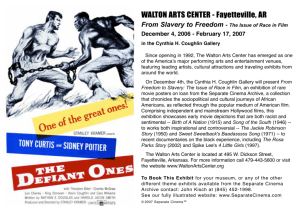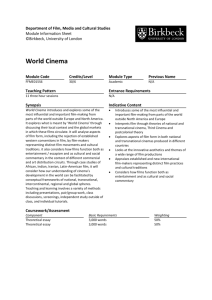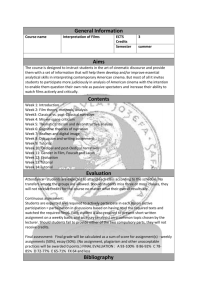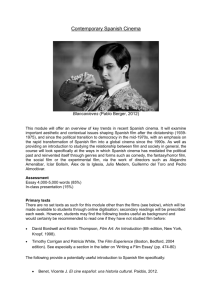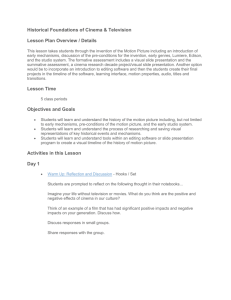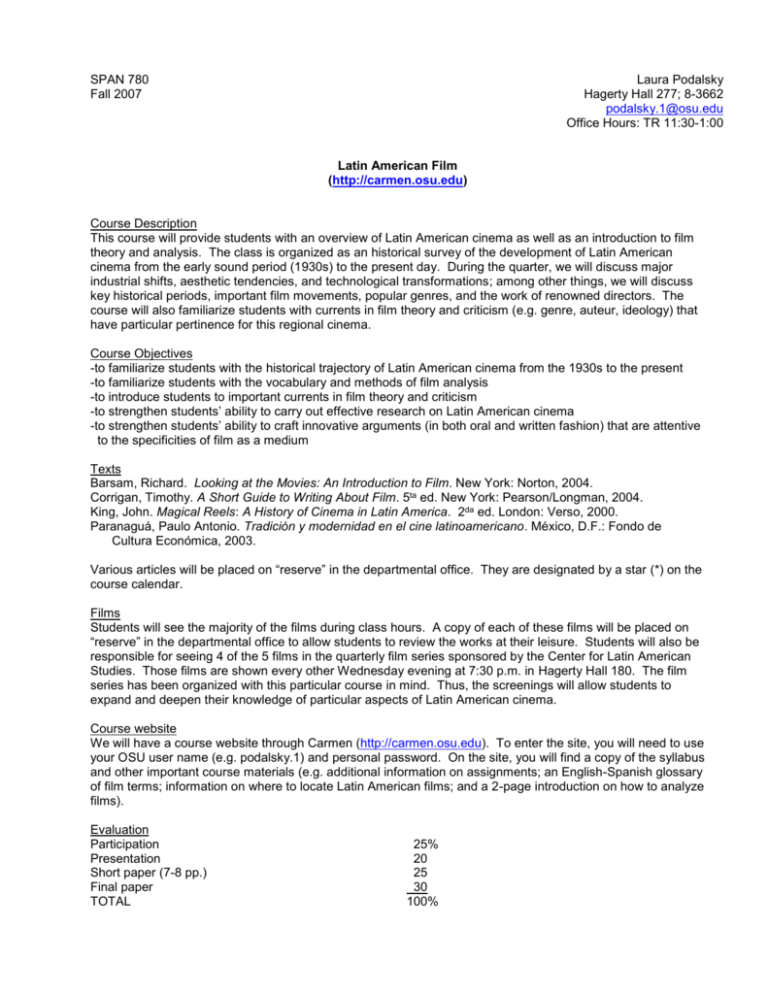
SPAN 780
Fall 2007
Laura Podalsky
Hagerty Hall 277; 8-3662
podalsky.1@osu.edu
Office Hours: TR 11:30-1:00
Latin American Film
(http://carmen.osu.edu)
Course Description
This course will provide students with an overview of Latin American cinema as well as an introduction to film
theory and analysis. The class is organized as an historical survey of the development of Latin American
cinema from the early sound period (1930s) to the present day. During the quarter, we will discuss major
industrial shifts, aesthetic tendencies, and technological transformations; among other things, we will discuss
key historical periods, important film movements, popular genres, and the work of renowned directors. The
course will also familiarize students with currents in film theory and criticism (e.g. genre, auteur, ideology) that
have particular pertinence for this regional cinema.
Course Objectives
-to familiarize students with the historical trajectory of Latin American cinema from the 1930s to the present
-to familiarize students with the vocabulary and methods of film analysis
-to introduce students to important currents in film theory and criticism
-to strengthen students’ ability to carry out effective research on Latin American cinema
-to strengthen students’ ability to craft innovative arguments (in both oral and written fashion) that are attentive
to the specificities of film as a medium
Texts
Barsam, Richard. Looking at the Movies: An Introduction to Film. New York: Norton, 2004.
Corrigan, Timothy. A Short Guide to Writing About Film. 5ta ed. New York: Pearson/Longman, 2004.
King, John. Magical Reels: A History of Cinema in Latin America. 2da ed. London: Verso, 2000.
Paranaguá, Paulo Antonio. Tradición y modernidad en el cine latinoamericano. México, D.F.: Fondo de
Cultura Económica, 2003.
Various articles will be placed on “reserve” in the departmental office. They are designated by a star (*) on the
course calendar.
Films
Students will see the majority of the films during class hours. A copy of each of these films will be placed on
“reserve” in the departmental office to allow students to review the works at their leisure. Students will also be
responsible for seeing 4 of the 5 films in the quarterly film series sponsored by the Center for Latin American
Studies. Those films are shown every other Wednesday evening at 7:30 p.m. in Hagerty Hall 180. The film
series has been organized with this particular course in mind. Thus, the screenings will allow students to
expand and deepen their knowledge of particular aspects of Latin American cinema.
Course website
We will have a course website through Carmen (http://carmen.osu.edu). To enter the site, you will need to use
your OSU user name (e.g. podalsky.1) and personal password. On the site, you will find a copy of the syllabus
and other important course materials (e.g. additional information on assignments; an English-Spanish glossary
of film terms; information on where to locate Latin American films; and a 2-page introduction on how to analyze
films).
Evaluation
Participation
Presentation
Short paper (7-8 pp.)
Final paper
TOTAL
25%
20
25
30
100%
Participation
Active participation is absolutely essential. Come to class prepared to discuss the film and the readings in
depth. You should have a clear understanding of the material and be ready to offer analytical
commentary.
Presentation
Each student will be responsible for a formal presentation on one of the films screened in class. Students
may work by themselves or in groups of two. The presentations must include some type of formal analysis
using film clips. The presentation will last no longer than 30 minutes. More information will be available on
the course website.
Papers
Each student will write two papers. The first paper is a “directed” work of 7-8 pages. In this short essay,
each student will present a formalist analysis of a particular film that is chosen on the basis of the student’s
interests and in consultation with the professor. Students must support their arguments through close
textual analysis that analyzes narrative structure and pertinent aspects of film language (mise-en-scene,
cinematography, editing, and sound). The second paper is more open-ended. Students can use their first
paper as a point of departure to expand and deepen their discussion of a particular topic or issue. Or they
can choose another topic of interest. Their critical approach will depend on the nature of their analysis;
however, students must still be attentive to the specificity of the medium.
The following list features a number of larger topics that student may choose to explore:
-questions of masculinity in the “old” or in the contemporary Mexican cinema
-the “author function” of directors like Fernando Solanas and Patricio Guzmán;
-globalization and “traveling directors” like Alfonso Cuarón y Guillermo del Toro;
-globalization and “transnational stars” like Gael García Bernal;
-historical representation in contemporary Brazilian or Mexican cinema;
-the representation of indigenous peoples in commercial films and/or alternative indigenous media;
-the return of genres in films from the 90s;
-the representation of homosexuality in contemporary cinema;
-the “nuevo cine pobre” and the work of Colombian director Víctor Gaviria;
-the significance of digital video (in the work of older, established directors like Jaime Humberto
Herrmosillo y Humberto Solás and in the work of newcomers like Julián Hernández)
Academic Misconduct
This course will not tolerate academic misconduct, such as plagiarism and dishonest practices in
connection with examinations. Consequently, I shall report all instances of alleged academic misconduct
to the Committee on Academic Misconduct, the institutional body designated to investigate all reported
cases of student academic misconduct. For additional information, see the Code of Student Conduct
(http://studentaffiars.osu.edu/info_for_students/csc.asp).
Disability statement
Anyone who feels they may need an accommodation based on the impact of a disability should contact me to
arrange an appointment as soon as possible. At the appointment we can discuss the course format, anticipate
your needs, and explore potential accommodations. I rely on the Office for Disability Services (ODS) for
assistance in verifying the need for accommodations; I encourage students to contact them as soon as
possible if they have not already done so (150 Pomerene Hall, 1760 Neil Avenue; 292-3307; TDD 292-0901;
www.ods.ohio-state.edu/).
2
Course Calendar
September
Th
22
I.
Introduction to Latin American Cinema and the Tools of Film Analysis
To read: Paranaguá, “Preámbulo” and “Deslindes”
To see: Controversia (Cuba, Rolando Díaz, c. 1984, 13’) and Testigos en cadena
(Argentina, Fernando Spiner 1984, 10’)
THE INDUSTRIAL DREAM (1930s-1950s)
T
27
Th
29
October
T
4
W
Th
5
6
T
11
Th
13
Early Sound Experiments in Cuba
To read: Paranaguá, “Industria”; *Feuer, “Dream Worlds and Dream Stages”;
Barsam, “Form and Narrative”; Corrigan, Cap. 1 and pp. 35-46
To see: Romance del palmar (Cuba, Ramón Peón, 1938, 92’)
Looking for a Formula: Music, Popular Theater and Cinema
To read: *López, “On Rhythms and Borders”; *Bhabha, “DissemiNation”
Industrial Consolidation and the Function of Stars
To read: King, pp. 41-54; Paranaguá, “Mito”; *Dyer, “Heavenly Bodies”; Barsam,
“Mise-en-scene and Design”; Corrigan, pp. 46-55
To see: Río Escondido (México, Emilio Fernández, 1947, 80’)
Film Series: María Candelaria (México, Emilio Fernández, 1943, 96’)
A “national” cinema?: The Case of Mexico
To read: *Ramírez Berg, “The Cinematic Invention of Mexico”;* Fein, “From
Collaboration to Containment”; Paranagua, “Triángulo”
Hybrid Genres
To read: King, pp. 54-60; Paranaguá, “Cosmopolitismo”; *López, “O Cangaceiro”
To see: clips from various chanchadas and O Cangaceiro (Brasil, Lima Barreto,
1953, 105’)
Peripheral Modernities and the Role of Cinema in Brazil
To read: *Mendonça, “Industria cultural y modernidad”; *Schwarz, “Brazilian
Culture”; *Vieira, “From High Noon to Jaws”
II. NEW CINEMAS (1950s-70s)
T
18
W
Th
19
20
T
25
Th
27
F
28
Auteur Cinema: The Case of Leopoldo Torre Nilsson
To read: King, pp. 79-84; Paranaguá, “Laberinto”; *Aguilar, “Leopoldo Torre
Nilsson”; Barsam, “Auteurism” (pp.428-29) and “Cinematography”;
Corrigan, pp. 55-62
To see: La casa del angel (Argentina, 1957, Leopoldo Torre Nilsson, 58’)
Film Series: La mano en la trampa (Argentina, 1961, Leopoldo Torre Nilsson, 89’)
Authorial Voices and Gendered Positions
To read:*Staiger, “Authorship Approaches”; *Kaplan, “Is the Gaze Male?”
Cinema Nôvo
To read: King, pp. 105-114; Paranaguá, “Movimiento”; *Rocha, “Uma estética do
fome”; Barsam, “Sound”; Corrigan, pp. 70-74
To see: Deus e o diabo na terra do sol (Brasil, Glauber Rocha, 1964, 120’)
Cinema and Modernity
To read: *Gomes, “Cinema”; *Rocha, “Revisión crítica del cine brasileiro”
HAND IN THE SHORT PAPER before 3:00 p.m.
3
November
T
1
Cinema and Nation in Revolutionary Cuba
To read: King, pp. 145-161; Paranaguá, “Laberinto” (pp. 213-220); *García
Espinosa, “Por un cine imperfecto”; Barsam, “Editing”; Corrigan, pp.
62-69
To see: La primera carga al machete (Cuba, Manuel Octavio Gómez, 1969, 84’)
Film Series: Memorias del subdesarrollo (1968, Tomás Gutiérrez Alea, 97’)
Historical Revisionism in a Revolutionary Context
To read: *García Borrero, “Para una relectura crítica…”; *Rosenstone, “The
Historical Film”
W
Th
2
3
T
8
Th
10
III.
CONTMPORARY CINEMA (1980s-2000s)
T
15
W
Th
16
17
T
22
Th
24
T
29
W
30
December
Th
The New Latin American Cinema
To read: King, pp. 65-72 y 84-89; *Fanon, “On National Culture”; Corrigan, Cap. 4
To see: La hora de los hornos, Parte I (Argentina, Fernando Solanas y Octavio
Getino, 90’)
A Pan-American Third Cinema?
To read: *Getino y Solanas, “Hacia un tercer cine”
Cinema and Woman
To read: King, 253-60, 270-75;*Xavier, “Brazilian Cinema in the 1990s”
Paranaguá, “Filiaciones” (pp. 244-63)
To see: Um ceu das estrelas (Brasil, Tata Amaral, 1996, 72’)
Film Series: Como nascem os anjos (Brasil, Murilo Salles, 1996, 100’)
Female Gazes
To read: Paranaguá, “Desafíos” (pp. 264-78); *de Lauretis, “Aesthetic and
Feminist Theory”
The End of State Support and the Possibilities of Digital Technologies
To read: King, 275-277; *García Espinosa, “La globalización de la cultura”;
*Venegas, “Cibernética imperfecta”; *Sobchack, “The Scene of the
Screen”
To see: Suite Habana (Cuba-España, Fernando Pérez, 2003, 84’)
THANKSGIVING HOLIDAY-No class
A New, Independent Cinema?: The Case of Argentina
To read: *Sánchez, “América Latina”; *Batlle, “De la virtual extinción; *Wolf, “Las
estéticas del nuevo cine argentino”
To see: Fuckland (Argentina, José Luis Marqués, 2000, 84’)
Film Series: Buenos Aires viceversa (Argentina-Países Bajos, Alejandro Agresti,
1996, 122’)
1
Cinema in the Era of Digital Technologies
To read: *Jenkins, “The Work of Theory…”
HAND IN THE FINAL PAPER on Monday, December 5 before noon
4
READINGS
Aguilar, Gonzalo. “Leopoldo Torre Nilsson: Un cineasta entre escritores.” In Leopoldo Torre Nilsson: Una
estética de la decadencia. María del Carmen Vieites, Ed. Buenos Aires: Museo del Cine Pablo C.
Duckós Hicken/Altamira, 2002.
Batlle, Diego. “De la virtual extinction a la nueva ley: el resurgimiento.” In Nuevo cine argentino: temas,
autores y estilos de una renovación. Horacio Bernades, Diego Lerer y Sergio Wolf, Eds. Buenos Aires:
Tatanka/FIPRESCI, 2002.
Bhabha, Homi. “DissemiNation: time, narrative, and the margins of the modern nation.” In Nation and
Narration. London: Routledge, 1990.
de Lauretis, Teresa. “Aesthetic and Feminist Theory: Rethinking Women’s Cinema.” In Female Spectators:
Looking at Film and Television. E. Deidre Pribram, Ed. London: Verso, 1988.
Dyer, Richard. “Heavenly Bodies: Film Stars and Society.” In Film and Theory: An Anthology. Robert Stam and
Toby Miller, Eds. Oxford: Blackwell, 2000.
Fanon, Frantz. “On National Culture.” In Colonial Discourse and Post-Colonial Theory: A Reader. Patrick
Williams y Laura Chrisman, Eds. New York: Columbia University Press, 1994.
Fein, Seth. “From Collaboration to Containment: Hollywood and the International Political Economy of Mexican
Cinema after the Second World War.” In Mexico’s Cinema: A Century of Film and Filmmakers. Joanna
Hershfield y David Maciel, Eds. Wilmington, DE: Scholarly Resources, 1999.
Feuer, Jane. “Dream Worlds and Dream Stages.” The Hollywood Musical. 2nd ed. Bloomington: Indiana
University Press, 1993.
García Borrero, Juan Antonio. “Para una relectura crítica de la década prodigiosa.” In La edad de herejía:
Ensayos sobre el cine cubano, su crítica y su público. Santiago de Cuba: Oriente, 2002.
García Espinosa, Julio. “La globalización de la cultura: nuevas tecnologías, posibles alternativas.” Cinemais
18 (1999): 71-78.
-------. “Por un cine imperfecto.” In Hojas de cine: Testimonios y documentos del nuevo cine latinoamericano.
Vol. III. México: Dirección General de Publicaciones y Medios, Secretaría de Educación Pública,
Fundación Mexicana de Cineastas, Universidad Autónoma Metropolitana, 1988.
Getino, Octavio and Fernando Solanas. “Hacia un Tercer Cine.” In Hojas de cine: Testimonios y documentos
del nuevo cine latinoamericano. Vol. I. México: Dirección General de Publicaciones y Medios,
Secretaría de Educación Pública, Fundación Mexicana de Cineastas, Universidad Autónoma
Metropolitana, 1988.
Gomes, Paulo Emilio Salles. “Cinema: Trajetória no subdesenvolvimento.” In Cinema: trajetória no
subdesenvolvimento. São Paulo: Paz e Terra, 1980.
[English translation: “Cinema: A Trajectory within Underdevelopment.” In Brazilian Cinema. Randal
Johnson and Robert Stam, Eds. 2nd ed. Austin: University of Texas Press, 1988.]
Jenkins, Henry. “The Work of Theory in the Age of Digital Transformation.”
http://web.mit.edu/21fms/www/faculty/henry3/pub/digitaltheory.htm
Kaplan, E. Ann. “Is the Gaze Male?” In Feminism and Film. Oxford: Oxford University Press, 2000.
López, Ana. “O Cangaceiro: estilos híbridos para un espacio nacional cinematográfico.” Archivos de la
Filmoteca 31 (1999): 172-83.
5
-------. “On Rhythms and Borders.” In Everynight Life: Culture and Dance in Latin America. José Estéban
Muñoz y Celeste Frase Delgado, Eds. Durham: Duke UP, 1997.
“Martín Fierro: apertura de un debate.” In Leopoldo Torre Nilsson: Una estética de la decadencia. María del
Carmen Vieites, Ed. Buenos Aires: Museo del Cine Pablo C. Duckós Hicken/Altamira, 2002.
Mendonça, Ana Rita. “Industria cultural y modernidad.” Archivos de la Filmoteca 36 (2000): 80-97.
Ramírez Berg, Charles, “The Cinematic Investion of Mexico: The Poetics and Politics of the FernándezFigueroa Style.” In The Mexican Cinema Project. Chon Noriega y Steven Ricci, Eds. Los Angeles:
UCLA Film and Television Archive, 1994.
Rocha, Glauber. “Uma estética da fome.” Revista Civilizacão Brasileiro 3 (1965): 165-170.
[English Translation: “An Esthetic of Hunger.” In Brazilian Cinema. Randal Johnson and Robert Stam,
Eds. 2nd ed. Austin: University of Texas Press, 1988.]
-------. “Revisión crítica del cine brasileño.” In Hojas de cine: Testimonios y documentos del nuevo cine
latinoamericano. Vol. I. México: Dirección General de Publicaciones y Medios, Secretaría de
Educación Pública, Fundación Mexicana de Cineastas, Universidad Autónoma Metropolitana, 1988.
Rosenstone, Robert. “The Historical Film: Looking at the Past in a Postliterate Age.” In The Historical Film:
History and Memory in Media. Marcia Landy, Ed. New Brunswick, NJ: Rutgers University Press, 2001.
Sánchez, Jorge. “América Latina: Los que no somos Hollywood.” Cinemais 31 (2001): 81-98.
Schwarz, Roberto. “Brazilian Culture: Nationalism by Elimination.” In Misplaced Ideas: Essays on Brazilian
Culture. London: Verso, 1992.
Sobchack, Vivian. “The Scene of the Screen: Envisioning Cinematic and Electronic “Presence.” In Film and
Theory: An Anthology. Robert Stam and Toby Miller, Eds. Malden, MA: Blackwell, 2000.
Staiger, Janet. “Authorship Approaches.” In Authorship and Film. David A. Gerstner y Janet Staiger, Eds. New
York: Routledge, 1996.
Vieira, João Luiz. “From High Noon to Jaws: Carnival and Parody in Brazilian Cinema.” In Brazilian Cinema.
2nd ed. Randal Johnson and Robert Stam, Eds. Austin: University of Texas Press, 1988.
Venegas, Cristina. “Cibernética imperfecta.” Miradas No.1 (2002) http://www.eictv.org/miradas/num_01/ojo_02.htm
Wolf, Sergio. “Las estéticas del nuevo cine argentino: el resurgimiento.” In Nuevo cine argentino: temas,
autores y estilos de una renovación. Horacio Bernades, Diego Lerer y Sergio Wolf, Eds. Buenos
Aires: Tatanka/FIPRESCI, 2002.
Xavier, Ismael. “Brazilian Cinema in the 1990s: The Unexpected Encounter and the Resentful Character.” In
The New Brazilian Cinema. Lucia Nagib, Ed. London: I.B.Tauris, 2003.
6


